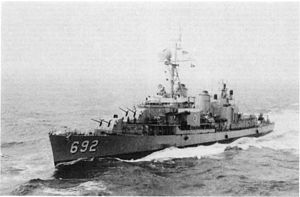
The Allen M. Sumner class was a group of 58 destroyers built by the United States during World War II. Another twelve ships were completed as destroyer minelayers. Often referred to as simply the Sumner class, this class was characterized by their twin 5-inch/38 caliber gun mounts, dual rudders, additional anti-aircraft weapons, and many other advancements over the previous Fletcher class. The Allen M. Sumner design was extended 14 feet (4.3 m) amidships to become the Gearing class, which was produced in larger numbers.
Completed in 1943–45, four were lost in the war and two were damaged so badly they were scrapped, but the surviving ships served in the US Navy into the 1970s. After being retired from the US fleet, 29 of them were sold to other navies, where they served many more years. Two still exist as museum ships, one in South Carolina, and one in Taiwan.
The first ship was laid down in May 1943, while the last was launched in April 1945. In that time the United States produced 58 Allen M. Sumner-class destroyers. The Allen M. Sumner class was an improvement of the previous Fletcher class, which were built from 1941 until 1944. In addition to three twin 5-inch/38 caliber gun mounts replacing the Fletchers' five single mounts, Sumners had twin rudders, giving them better maneuverability for ASW work when compared to Fletchers. The 5-inch guns were guided by a Mark 37 Gun Fire Control System with a Mark 25 fire control radar linked by a Mark 1A Fire Control Computer stabilized by a Mark 6 8,500 rpm gyro. This fire control system provided effective long-range anti-aircraft (AA) or anti-surface fire. The Allen M. Sumners also had much more short-range anti-aircraft armament than the Fletchers, with 12 40 mm guns and 11 20 mm guns compared with 8 40 mm and 7 20 mm for a typical late-war upgraded Fletcher. The initial design retained the Fletchers' heavy torpedo armament of 10 21-inch (533 mm) tubes in two quintuple mounts, firing the Mark 15 torpedo. As the threat from kamikaze aircraft mounted in 1945, and with few remaining Japanese warships to use torpedoes on, most of the class had the aft quintuple 21-inch torpedo tube mount replaced by an additional 40 mm quadruple mount for 16 total 40 mm guns.